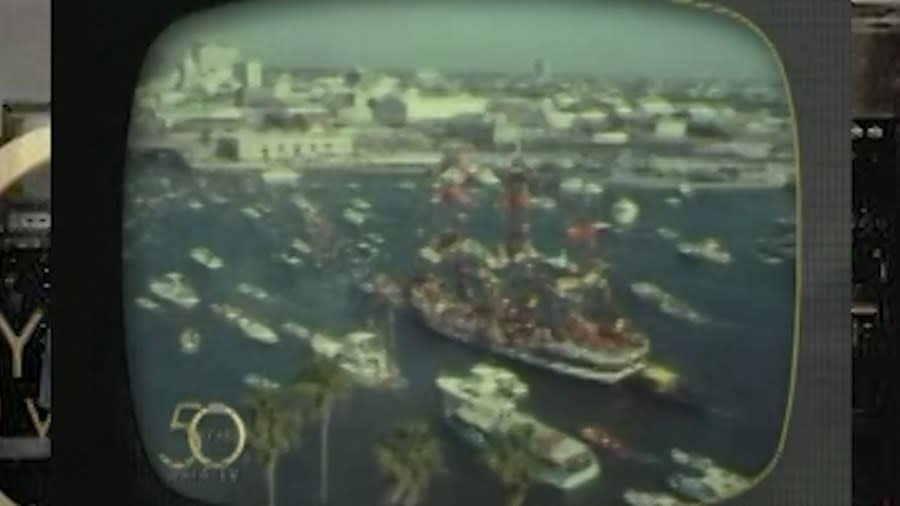Gasparilla history: Why does Tampa celebrate a fictional pirate?

TAMPA, Fla. (WFLA) — Every year since 1904, Tampa Bay has been invaded by pirates, whether by land or sea, on horseback or by galleon. Sometimes, they even take the Tampa mayor hostage to ransom for the key to the city.
The origins of Gasparilla, both invasion and parade, are owed to what Ye Mystic Krewe of Gasparilla call the “last of the Buccaneers,” the “legendary” pirate captain José Gaspar.
2024 Gasparilla schedule of events
The original Gasparilla Krewe in Tampa Bay says that Gaspar “terrorized the coastal waters of West Florida” in the 18th and 19th centuries, with multiple tales of his background and story before reaching legendary pirate status.
The first written account of Gaspar’s marauding come from a brochure for the Gasparilla Inn on Gasparilla Island, located just 100 miles south of Tampa Bay in Charlotte County.
The legend of José Gaspar, according to an account by André-Marcel d’Ans and translated by Marie-Joèle Ingalls, Gaspar was a Spanish naval officer, who in the early 1780s mutinied against his captain, stole a ship, and fled to the Gulf of Mexico to become a pirate and raid the West Florida Coast for the next 40 years.

One version of the Gaspar’s origin story said he escaped a naval battle with the English, lost his drive to be a naval officer, and chose to find “his own wealth and fame” as a pirate instead, convincing his crew to join with him and kill the ship’s captain, according to d’Ans’ account.
Another version of the legend says Gaspar’s path to piracy started at the tender age of 12, where he kidnapped a young girl and was offered a choice to join the Spanish Navy or go to prison. As an adult, the second origin story says he was made midshipman after seducing the academy commander’s niece, and describing him as skilled with weapons and very intelligent.
LIVE BLOG: Gasparilla Parade of Pirates takes over Bayshore Boulevard
WATCH LIVE: Gasparilla pirates parade down Bayshore Boulevard
The tale continues, alleging that Gaspar fought the Barbary pirates of Tripoli before making captain, then sailed to the Caribbean to fight and capture the buccaneers, before rising to admiral of the Atlantic Fleet and working with King Charles III. This version says the king’s daughter-in-law fell in love with him, and when he rejected her, she framed him for stealing the crown jewels and he fled to be a pirate and take revenge, according to d’Ans.
Across all of the tales of José Gaspar, d’Ans’ accounts of his origins have certain common details.
“In 1783, having become a traitor and a pirate, José Gaspar gave the name of “Gasparilla” to himself as well as to his ship and the island in Charlotte Harbor, on the west coast of Florida near Fort Myers, where he established his den,” according to d’Ans.

For the next 38 years, from 1783 to 1821, the self-named Gasparilla wreaked havoc on merchant ships and sailors, executing “without mercy all the crews” aside from some sailors who they took in to replace their own losses.
Women on the ships were taken as “slaves and concubines” to serve until they failed to please the crew or were replaced by “fresher” captures, then beheaded. They were allegedly kept on “Captiva Island,” near Gasparilla’s base on Gasparilla Island.
D’Ans said Gaspar chose to retire, but was tempted back into piracy with one last job, after a “rich British merchant ship” was seen near the pirate’s hide-out in Charlotte Harbor. However, d’Ans said the ship was actually an American warship in disguise, the U.S.S. Enterprise. It fired upon the pirate ship “with deadly accuracy.”
Gaspar was said to have refused to surrender, instead jumping into the sea.
While the legends of José Gaspar are full of alleged adventure and swashbuckling, history tells a different story.

Gaspar’s story is notably absent from the annals of history, fleet records and even wanted posters. Instead, history shows that Florida’s 20th governor, Albert W. Gilchrist owned a hotel on Gasparilla Island. He bought land at Boca Grande in 1897, an outpost, and wanted to develop it into a town.
Writing on Gaspar was not found until 1900, in a Boca Grande Hotel advertisement brochure, according to d’Ans. The brochures were reported to have been handed out by Charlotte Harbor and Northern Railroad company, with the leaflets containing Gaspar’s legend.
Despite the distance from Tampa Bay, the legend washed ashore and took root four years later, according to Ye Mystic Krewe. History of Gasparilla published by the City of Tampa said pirates have invaded ever since.
“Since 1905, pirates have invaded Tampa Bay. Every year, the unruly plunderers take over the city in honor of the mythical legendary pirate Jose Gaspar,” according to event history published by the City of Tampa. “The original members of Ye Mystic Krewe of Gasparilla stormed Tampa on horseback before becoming seaworthy in 1911. The success of those early invasions prompted planners to move the celebrati
For the latest news, weather, sports, and streaming video, head to WFLA.

